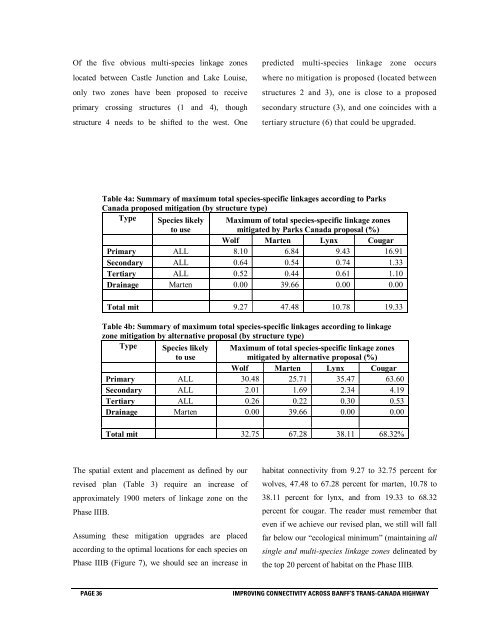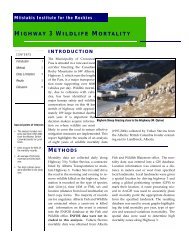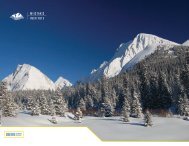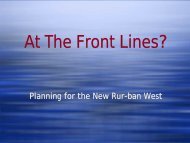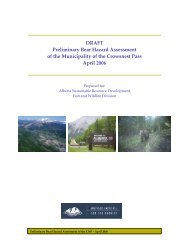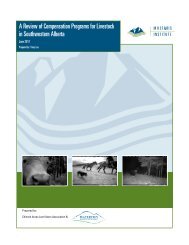A GIS based approach to restoring connectivity across Banff's Trans ...
A GIS based approach to restoring connectivity across Banff's Trans ...
A GIS based approach to restoring connectivity across Banff's Trans ...
Create successful ePaper yourself
Turn your PDF publications into a flip-book with our unique Google optimized e-Paper software.
Of the five obvious multi-species linkage zones<br />
located between Castle Junction and Lake Louise,<br />
only two zones have been proposed <strong>to</strong> receive<br />
primary crossing structures (1 and 4), though<br />
structure 4 needs <strong>to</strong> be shifted <strong>to</strong> the west. One<br />
predicted multi-species linkage zone occurs<br />
where no mitigation is proposed (located between<br />
structures 2 and 3), one is close <strong>to</strong> a proposed<br />
secondary structure (3), and one coincides with a<br />
tertiary structure (6) that could be upgraded.<br />
Table 4a: Summary of maximum <strong>to</strong>tal species-specific linkages according <strong>to</strong> Parks<br />
Canada proposed mitigation (by structure type)<br />
Type<br />
Species likely<br />
<strong>to</strong> use<br />
Maximum of <strong>to</strong>tal species-specific linkage zones<br />
mitigated by Parks Canada proposal (%)<br />
Wolf Marten Lynx Cougar<br />
Primary ALL 8.10 6.84 9.43 16.91<br />
Secondary ALL 0.64 0.54 0.74 1.33<br />
Tertiary ALL 0.52 0.44 0.61 1.10<br />
Drainage Marten 0.00 39.66 0.00 0.00<br />
Total mit 9.27 47.48 10.78 19.33<br />
Table 4b: Summary of maximum <strong>to</strong>tal species-specific linkages according <strong>to</strong> linkage<br />
zone mitigation by alternative proposal (by structure type)<br />
Type<br />
Species likely<br />
<strong>to</strong> use<br />
Maximum of <strong>to</strong>tal species-specific linkage zones<br />
mitigated by alternative proposal (%)<br />
Wolf Marten Lynx Cougar<br />
Primary ALL 30.48 25.71 35.47 63.60<br />
Secondary ALL 2.01 1.69 2.34 4.19<br />
Tertiary ALL 0.26 0.22 0.30 0.53<br />
Drainage Marten 0.00 39.66 0.00 0.00<br />
Total mit 32.75 67.28 38.11 68.32%<br />
The spatial extent and placement as defined by our<br />
revised plan (Table 3) require an increase of<br />
approximately 1900 meters of linkage zone on the<br />
Phase IIIB.<br />
Assuming these mitigation upgrades are placed<br />
according <strong>to</strong> the optimal locations for each species on<br />
Phase IIIB (Figure 7), we should see an increase in<br />
habitat <strong>connectivity</strong> from 9.27 <strong>to</strong> 32.75 percent for<br />
wolves, 47.48 <strong>to</strong> 67.28 percent for marten, 10.78 <strong>to</strong><br />
38.11 percent for lynx, and from 19.33 <strong>to</strong> 68.32<br />
percent for cougar. The reader must remember that<br />
even if we achieve our revised plan, we still will fall<br />
far below our “ecological minimum” (maintaining all<br />
single and multi-species linkage zones delineated by<br />
the <strong>to</strong>p 20 percent of habitat on the Phase IIIB.<br />
PAGE 36<br />
IMPROVING CONNECTIVITY ACROSS BANFF’S TRANS-CANADA HIGHWAY


